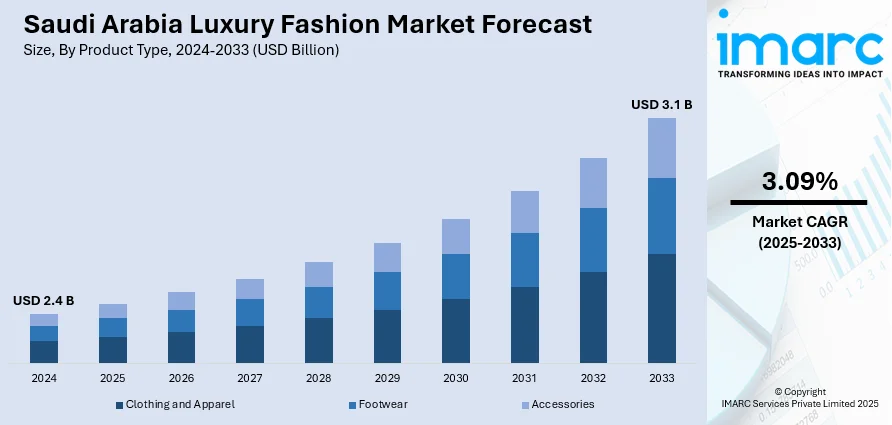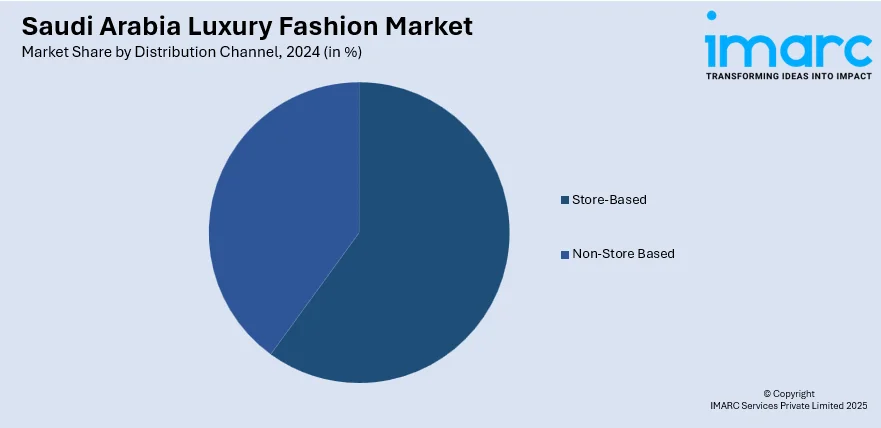
Saudi Arabia Luxury Fashion Market Size, Share, Trends and Forecast by Product Type, Distribution Channel, End User, and Region, 2025-2033
Saudi Arabia Luxury Fashion Market Overview:
The Saudi Arabia luxury fashion market size reached USD 2.4 Billion in 2024. Looking forward, IMARC Group expects the market to reach USD 3.1 Billion by 2033, exhibiting a growth rate (CAGR) of 3.09% during 2025-2033. The market share is expanding, driven by rising collaborations between influencers and luxury brands, offering limited-edition high-end collections, along with the increasing implementation of government initiatives aimed at boosting tourism activities.
|
Report Attribute
|
Key Statistics
|
|---|---|
|
Base Year
|
2024 |
|
Forecast Years
|
2025-2033
|
|
Historical Years
|
2019-2024
|
| Market Size in 2024 | USD 2.4 Billion |
| Market Forecast in 2033 | USD 3.1 Billion |
| Market Growth Rate 2025-2033 | 3.09% |
Saudi Arabia Luxury Fashion Market Trends:
Increasing popularity of fashion influencers
The growing popularity of fashion influencers is offering a favorable Saudi Arabia luxury fashion market outlook. With a rising number of social media users across digital platforms, fashion influencers are gaining immense visibility and shaping user preferences, especially among younger audiences. According to the DataReportal, in January 2024, Saudi Arabia had 35.10 Million social media users, representing 94.3% of its entire population. These influencers often showcase high-end brands and luxury lifestyle choices, creating a sense of aspiration among their followers who are keen to adopt similar looks. Their posts, stories, and reviews act as powerful marketing tools for luxury labels, helping to bridge the gap between international fashion trends and the local market. Collaborations between influencers and luxury brands are becoming common, offering limited-edition collections or exclusive promotions that entice significant attention. This influencer-based trend is encouraging luxury fashion brands to broaden their digital presence and engage with people more directly. As influencers continue to grow their fan base and gain credibility, their impact on purchasing behavior becomes stronger, making them a key driver in the expansion of the luxury fashion segment in the country.

Rising supportive government initiatives to boost tourism
The increasing execution of government initiatives aimed at boosting tourism activities is fueling the Saudi Arabia luxury fashion market growth. The country continues to implement strategic plans to diversify its economy and attract international visitors. In March 2024, the Ministry of Tourism, together with the Ministry of Investment, unveiled the ‘Hospitality Sector Investment Enablers Initiative’. This program sought to enhance and diversify tourism options, strengthening the capabilities of hospitality venues in selected tourist locations throughout the Kingdom. Programs like Vision 2030 encourage the development of tourism through the opening of new resorts, heritage sites, and entertainment zones, which bring in affluent travelers and create demand for high-end fashion. With more international tourists arriving in major cities, such as Riyadh and Jeddah, luxury fashion retailers find greater opportunities to showcase their collections and increase their sales. The government is also easing visa policies and improving infrastructure, making it easier for tourists to explore the country and spend on premium experiences, including shopping. As the hospitality sector is thriving, the retail ecosystem surrounding it is expanding, with malls and boutiques broadening their offerings to meet the tastes of an upscale clientele. Events like fashion weeks, cultural festivals, and international exhibitions supported by public and private partnerships are also helping to elevate the image of luxury fashion in the region. Regional users, influenced by this exposure and rising international trends, are showing a stronger inclination towards designer labels. Together, tourism and fashion are becoming closely linked, propelling the overall growth of the luxury fashion market in Saudi Arabia.
Saudi Arabia Luxury Fashion Market Segmentation:
IMARC Group provides an analysis of the key trends in each segment of the market, along with forecasts at the regional level for 2025-2033. Our report has categorized the market based on product type, distribution channel, and end user.
Product Type Insights:
- Clothing and Apparel
- Jackets and Coats
- Skirts
- Shirts and T-Shirts
- Dresses
- Trousers and Shorts
- Denim
- Underwear and Lingerie
- Others
- Footwear
- Accessories
- Gems and Jewelry
- Belts
- Bags
- Watches
The report has provided a detailed breakup and analysis of the market based on the product type. This includes clothing and apparel (jackets and coats, skirts, shirts and t-shirts, dresses, trousers and shorts, denim, underwear and lingerie, and others), footwear, and accessories (gems and jewelry, belts, bags, and watches).
Distribution Channel Insights:

- Store-Based
- Non-Store Based
A detailed breakup and analysis of the market based on the distribution channel have also been provided in the report. This includes store-based and non-store based.
End User Insights:
- Men
- Women
- Unisex
The report has provided a detailed breakup and analysis of the market based on the end user. This includes men, women, and unisex.
Regional Insights:
- Northern and Central Region
- Western Region
- Eastern Region
- Southern Region
The report has also provided a comprehensive analysis of all the major regional markets, which include Northern and Central Region, Western Region, Eastern Region, and Southern Region.
Competitive Landscape:
The market research report has also provided a comprehensive analysis of the competitive landscape. Competitive analysis such as market structure, key player positioning, top winning strategies, competitive dashboard, and company evaluation quadrant has been covered in the report. Also, detailed profiles of all major companies have been provided.
Saudi Arabia Luxury Fashion Market News:
- In July 2024, Dubai’s Etoile Group broadened its luxury retail presence throughout the Gulf region, encompassing Saudi Arabia, Bahrain, Qatar, and the UAE, launching 11 new boutiques for luxury fashion brands, such as Etoile La Boutique, Aquazzura, Tod’s, Etro, and Chanel. The firm launched new stores for Chanel, Tod’s, and Etro throughout the Gulf region in the first half of 2024.
Saudi Arabia Luxury Fashion Market Report Coverage:
| Report Features | Details |
|---|---|
| Base Year of the Analysis | 2024 |
| Historical Period | 2019-2024 |
| Forecast Period | 2025-2033 |
| Units | Billion USD |
| Scope of the Report |
Exploration of Historical Trends and Market Outlook, Industry Catalysts and Challenges, Segment-Wise Historical and Future Market Assessment:
|
| Product Types Covered |
|
| Distribution Channels Covered | Store-Based, Non-Store Based |
| End Users Covered | Men, Women, Unisex |
| Regions Covered | Northern and Central Region, Western Region, Eastern Region, Southern Region |
| Customization Scope | 10% Free Customization |
| Post-Sale Analyst Support | 10-12 Weeks |
| Delivery Format | PDF and Excel through Email (We can also provide the editable version of the report in PPT/Word format on special request) |
Key Questions Answered in This Report:
- How has the Saudi Arabia luxury fashion market performed so far and how will it perform in the coming years?
- What is the breakup of the Saudi Arabia luxury fashion market on the basis of product type?
- What is the breakup of the Saudi Arabia luxury fashion market on the basis of distribution channel?
- What is the breakup of the Saudi Arabia luxury fashion market on the basis of end user?
- What is the breakup of the Saudi Arabia luxury fashion market on the basis of region?
- What are the various stages in the value chain of the Saudi Arabia luxury fashion market?
- What are the key driving factors and challenges in the Saudi Arabia luxury fashion market?
- What is the structure of the Saudi Arabia luxury fashion market and who are the key players?
- What is the degree of competition in the Saudi Arabia luxury fashion market?
Key Benefits for Stakeholders:
- IMARC’s industry report offers a comprehensive quantitative analysis of various market segments, historical and current market trends, market forecasts, and dynamics of the Saudi Arabia luxury fashion market from 2019-2033.
- The research report provides the latest information on the market drivers, challenges, and opportunities in the Saudi Arabia luxury fashion market.
- Porter's five forces analysis assist stakeholders in assessing the impact of new entrants, competitive rivalry, supplier power, buyer power, and the threat of substitution. It helps stakeholders to analyze the level of competition within the Saudi Arabia luxury fashion industry and its attractiveness.
- Competitive landscape allows stakeholders to understand their competitive environment and provides an insight into the current positions of key players in the market.
Need more help?
- Speak to our experienced analysts for insights on the current market scenarios.
- Include additional segments and countries to customize the report as per your requirement.
- Gain an unparalleled competitive advantage in your domain by understanding how to utilize the report and positively impacting your operations and revenue.
- For further assistance, please connect with our analysts.
 Request Customization
Request Customization
 Speak to an Analyst
Speak to an Analyst
 Request Brochure
Request Brochure
 Inquire Before Buying
Inquire Before Buying




.webp)




.webp)












